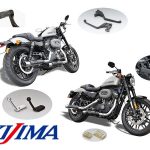A cable tie is a maintenance necessity, useful for holding together wiring harnesses and hoses. It is easy to use because all you have to do is tie something together and cut the ends, but the cutting part is sharper than you might imagine, and if you rub it without realizing it, you can injure your hand or arm. In such cases, plastic nippers, which have thinner blades than standard nippers, are useful.
Like knives, nippers should be used according to the counterpart to be cut.

These nippers are bundling band 2-way nippers manufactured by 3 PEAKS, featuring two different profiles of blades incorporated into a single nipper. The inside of the grip is equipped with a plastic spring to reduce fatigue when working for long hours at mass production sites.

The base part is a V-shaped strong nipper with blades on both the front and back, while the tip marked "For Plastic" is a plastic nipper with a flat front blade. The plastic nipper part has a thin blade, so be careful when using it against a hard partner, as the blade is prone to spillage.
Nippers and radio pliers are the most popular grabbing tools regardless of whether you are interested in motorcycle or automobile maintenance, and it is no exaggeration to say that there are nippers in every house for cutting wiring, and cable.
The orthodox nippers, commonly called "strong nippers," are characterized by their versatility in cutting iron wire, copper wire, stranded wire, and other metal materials with ease. And factors such as dimensions, cutting ability, and hardness and strength of the blade are defined by JIS. However, nippers that have acquired the JIS standard are not necessarily the strongest and best.
Spanners and screwdrivers must be used according to the size and specifications of each tool. An 8mm spanner will not fit a bolt with a 2-sided width of 10mm, and a 12mm will strike out. A 3# screwdriver will not fit a #2 equivalent cross-hole.
However, nippers are often forced to do something reckless or unreasonable, regardless of the product's suitability or capability. In some cases, nippers are used in situations that exceed their original capabilities without the user noticing. It is inevitable that the blade will spill or be damaged, but on the other hand, there seems to be a tendency to choose sturdy products that do not break even if handled a little roughly.
It may seem that the stronger the blade edge and the more easily thick and hard materials can be cut with nippers, the easier they are to use in any situation, but this is not necessarily true in terms of the basic premise of a knife. In the case of knives used for cooking, a kitchen knife is useful for cutting fish with hard bones, but a knife with a thinner blade is better suited for peeling radish.
The same applies to nippers. Strong nippers have a V-shaped cross-section of the blade to bite firmly into hard materials. Some tool manufacturers call both sides from the apex of the V-shape "front blade" and "back blade," but it seems that the angle of the V-shape is taken into consideration to realize a strong cutting edge that is hard to spill. Nippers with a large blade surface also have a weak point of leaving a residue on the cutting surface when cutting soft materials.
Cutting ties is an annoying and sometimes dangerous part of motorcycle maintenance. Tie-wraps, cable tie, and other such items are called by different manufacturers and brands, but ties are very useful for holding together wiring and hoses, as they lock into place with a single-handed tug. The excess is removed by cutting it off with nippers, but be careful, as the cut ends will leave a sharp, piled-up residue that can cause bruising and abrasions if rubbed on the hands or arms.
- Point 1: The cutting edges of strong nippers, which can cut hard materials, are V-shaped, and the cut left over when cutting bundling bands may cause abrasions.
Plastic nippers with a flattened front edge to eliminate residual cutting.

By pressing a flat blade edge on the front side against the locking portion of the cable ties, the cut surface will be flat like cutting paper with a cutting machine. If the harness under the fuel tank is bundled with ties and the ends are not properly processed, the next time you stick your hand in for maintenance, you may injure yourself with a leftover cut. This danger can be avoided with a single nipper.

The cutting portion is flush with the locking portion, so it does not catch on the fingertips or palm of the hand when slid over. The advantage of using plastic nippers is not limited to the prevention of injury, as any leftover cut can fray a soldier's hand or tear a nitrile glove.
In such cases, plastic nippers specially designed for plastic materials come in handy. These nippers have a flat front blade and the cutting surface is finished flat. As experienced plastic model riders will know, a major feature of these nippers is that they can cut so sharply and crisply that there is no need to use a file when separating parts from the runner.
If plastic nippers are used to cut the excess portion of the bandage, the cut portion and the locking portion of the band will be flush with each other, and there is no danger of injury from hand contact. Even with strong nippers, if you cut against the locking portion, the remaining cut will be much smaller, but if you rub your arm against the remaining part like a spike, you may get hurt.
Once you use plastic nippers to cut bundling bands, everyone will be convinced of the quality and safety of the finished product, but if you accidentally use them on metal such as wire, the blades can easily spill. However, if used incorrectly on metal such as wire, they can easily spill. It may be troublesome to keep two tools at hand, a strong nipper and a plastic nipper, but the finished product will be better if you use each one separately.
The nipper shown in the image is a product with a plastic nipper with a flat front edge at the tip of the blade and a strong nipper with a front edge at the base of the blade. This allows you to kill two birds with one stone, adjusting the length of wiring while cutting the ties that secure the harnesses beautifully and safely. In some cases, when trying to cut wiring or stainless steel wire locks in a narrow area, you may not be able to reach the base of the blade and eventually need strong nippers as well, but there is a risk of blade spillage if you try to cut with a thin blade tip there, so use the right tool for the right job at the right time.
Some may argue that nippers are a hassle unless one can cut everything with one tool, but everyone can agree that the best results are achieved by using different axes, knives, and cutter knives. Plastic nippers, which can clean up the edges and reduce the risk of injury, are tools that we recommend using with a set of tying bands.
- Point 1: Plastic nippers require more delicate handling than strong nippers, but the front blade is flat and leaves no residue, reducing the risk of injury from the cutting portion of the binding band.



